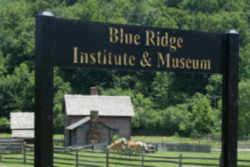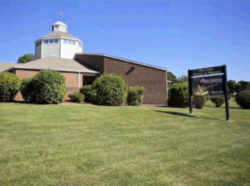
Virginia Symbols
Virginia Blue Ridge Folklore State Center
The Blue Ridge Institute

Ferrum, Virginia
Adopted in 1986
Virginia designated the Blue Ridge Institute in Ferrum, Virginia as the official state folklore center in 1986. Through gallery
exhibits, the Blue Ridge Folklife Festival, the Blue Ridge Farm Museum, the Blue Ridge Heritage Archive, the recordings series,
and innovative outreach programming, the Blue Ridge Institute promotes a special understanding of regional folklife by documenting the folkways of
the people living in and around the Blue Ridge Mountains.
Virginia Blue Ridge
Folklore State Center:
The Blue Ridge Institute

For more than two decades Ferrum College's Blue Ridge Institute & Museum has documented, interpreted and presented the traditional life and culture of the Blue Ridge and its people. Designated the State Center for Blue Ridge Folklore by the Virginia General Assambly in 1986, the Institute promotes an understanding of regional folklore past and present for all ages.
The Institute highlights music, crafts and decorative arts. Visitors can witness folk culture through gallery exhibits and a 17th-Century German-American farmstead.
Visitors are often astounded that a small Methodist-related college in Franklin County, Virginia, has taken on the role of preserving a cultural heritage to the extent and level of visibility that Ferrum College has done. The result, the Blue Ridge Institute, along with the Blue Ridge Farm Museum and its Folklife Festival, places Ferrum among the nation's most important colleges culturally. Its archives contain thousands of photos, videotapes, phonograph records, vintage books and manuscripts, all treasure troves of Appalachian scenes and people, Shenandoah Valley beliefs, Southwest Virginia folktales and African-American and Caucasian folk music from throughout Virginia. People of English, Scot, Irish, African and German descent will be especially interested in the distinct identities reflected in Blue Ridge music, crafts, foods, beliefs and customs formed after their forebears came to America. The Institute is open Monday through Friday 8 AM to 4:30 PM. Archives are open by appointment
The Blue Ridge Institute of Ferrum College, the State Center for Blue Ridge Folklore, presents the folkways of the region and Virginia as a whole through two unique museum facilities. The Blue Ridge Farm Museum, which presents the history and culture of early Southwest Virginia settlements, features a c. 1800 German-American farmstead with log house, outdoor oven, outbuildings, livestock and gardens revealing the daily life of settlers who came from the German communities of Pennsylvania and the Shenandoah Valley.All buildings are authentic and were moved from their original Blue Ridge locations. Heirloom vegetables flourish in the gardens, vintage breeds of livestock shelter by the barn, and costumed interpreters work at farm and household chores true to early life in the region.
Both historical and contemporary folkways engage the visitor in the Institute's Museum Galleries. Two rotating exhibits showcase the rich texture of Virginia folklife in music, crafts, art and customs. The Museum Galleries are the only facilities in the Commonwealth dedicated exclusively to the presentation of traditional culture. The Farm Museum is open weekends from mid-May through mid-August, Saturday 10 AM to 5 PM and Sundays 1 to 5 PM. Admission is $3 for adults and $2 for children and senior citizens. Museum Galleries are open year round Monday through Saturday 10 AM to 4 PM. Admission is free.
Virginia Law
The law designating the Blue Ridge Institute located in the village of Ferrum. as the official Virginia state blue ridge folklore state center is found in the Code of Virginia, Title 1, Chapter 5, Section 1-510. Virginia symbols were re-organized under one section of the Code of Virginia in 2005.
Title 1 - GENERAL PROVISIONS.
Chapter 5 - Emblems
§ 1-510. Official emblems and designations.
The following are hereby designated official emblems and designations of the Commonwealth:
Artisan Center - "Virginia Artisans Center," located in the City of Waynesboro.
Bat - Virginia Big-eared bat (Corynorhinos townsendii virginianus).
Beverage - Milk.
Blue Ridge Folklore State Center - Blue Ridge Institute located in the village of Ferrum.
Boat - "Chesapeake Bay Deadrise."
Covered Bridge Capital of the Commonwealth - Patrick County.
Covered Bridge Festival - Virginia Covered Bridge Festival held in Patrick County.
Dog - American Foxhound.
Emergency medical services museum - "To The Rescue," located in the City of Roanoke.
Fish - Brook Trout.
Fleet - Replicas of the three ships, Susan Constant, Godspeed, and Discovery, which comprised the Commonwealth's founding fleet that brought
the first permanent English settlers to Jamestown in 1607, and which are exhibited at the Jamestown Settlement in Williamsburg.
Flower - American Dogwood ( Cornus florida).
Folk dance - Square dancing, the American folk dance that traces its ancestry to the English Country Dance and the French Ballroom Dance, and is called,
cued, or prompted to the dancers, and includes squares, rounds, clogging, contra, line, the Virginia Reel, and heritage dances.
Fossil - Chesapecten jeffersonius.
Gold mining interpretive center - Monroe Park, located in the County of Fauquier.
Insect - Tiger Swallowtail Butterfly (Papilio glaucus Linne).
Motor sports museum - "Wood Brothers Racing Museum and Virginia Motor Sports Hall of Fame," located in Patrick County.
Outdoor drama - "The Trail of the Lonesome Pine Outdoor Drama," adapted for the stage by Clara Lou Kelly and performed in the Town of Big
Stone Gap.
Outdoor drama, historical - "The Long Way Home" based on the life of Mary Draper Ingles, adapted for the stage by Earl Hobson Smith, and
performed in the City of Radford.
Shell - Oyster shell (Crassostrea virginica).
Song emeritus - "Carry Me Back to Old Virginia," by James A. Bland, as set out in the House Joint Resolution 10, adopted by the General Assembly
of Virginia at the Session of 1940.
Sports hall of fame - "Virginia Sports Hall of Fame," located in the City of Portsmouth.
War memorial museum - "Virginia War Museum," (formerly known as the War Memorial Museum of Virginia), located in the City of Newport News.
(Code 1950, § 7-35, 7-36, 7-37; 1966, cc. 102, 547, § 7.1-37, 7.1-38, 7.1-39; 1974, c. 24, § 7.1-40; 1982, c. 191, § 7.1-40.1;
1986, c. 138, § 7.1-40.2; 1988, c. 317, § 7.1-40.3; 1991, cc. 71, 575, § 7.1-40.4, 7.1-40.5; 1993, cc. 251, 509, § 7.1-40.6; 1994,
cc. 33, 134, 220, 464, § 7.1-40.2:1, 7.1-40.8; 1995, cc. 12, 180, § 7.1-40.2:2; 1996, c. 52, § 7.1-40.9; 1997, cc. 66, 576, § 7.1-40.10;
1999, cc. 69, 336, § 7.1-40.11; 2001, cc. 97, 134, § 7.1-40.12; 2001, c. 228, § 7.1-40.13; 2005, cc. 557, 839; 2006, c. 128; 2007, cc.
391, 685; 2008, c. 262.)







